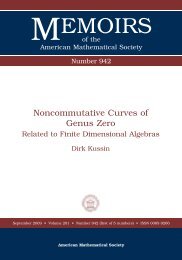University of Paderborn Department of Mathematics Diploma Thesis ...
University of Paderborn Department of Mathematics Diploma Thesis ...
University of Paderborn Department of Mathematics Diploma Thesis ...
You also want an ePaper? Increase the reach of your titles
YUMPU automatically turns print PDFs into web optimized ePapers that Google loves.
14 CHAPTER 1. NOTATIONS AND PREREQUISITES(i) Let p(z) = 2z+1 be the given Hilbert polynomial. Now we proceed as in Remark 1.11to compute m 0 and m 1 : In the terminology above we get ( r = 1)and( thus m 1 = ) 1!·2 =z + 1 z + 1 − 22. Then we compute the polynomial ˜p(z) := p(z) − += 2.22Hence, it follows m 0 = 0! · 2 = 2. Thus, we write p(z) = 2z + 1 in the form( ) ( ) ( ( )z + 1 z − 1 z z − 2p(z) = − + − .2 2 1)1(ii) Consider the Hilbert polynomial p(z) = 2z 2 + 2z + 1. In the terminology <strong>of</strong> Remark1.11, we have r = 2. Following ( the above ) description ( ) provides m 2 = 2! · 2 = 4.z + 2 z − 2Hence, we obtain ˜p(z) := p(z) − + = 6z − 3. Next, we compute3 ( ) 3 ( )z + 1 z − 5m 1 = 1! · 6 = 6 and set ˜p(z) := ˜p(z) − + = 12. Finally, it follows2 2m 0 = 12 and we write p(z) as( ) ( ) ( ) ( ) ( ( )z + 2 z − 2 z + 1 z − 5 z z − 12p(z) = − + − + − .3 3 2 2 1)1We will make use <strong>of</strong> this special representation <strong>of</strong> Hilbert polynomials and, in particular,<strong>of</strong> the sequence m 0 , . . . , m r later. Their values will help to compute the set <strong>of</strong> generators<strong>of</strong> a special lexicographic ideal, which can be associated to a given Hilbert polynomial p(z).In the last part <strong>of</strong> this chapter we state a result to characterize Hilbert functions accordingto F.S. Macaulay. It will be useful in various pro<strong>of</strong>s later within this thesis, for examplewhen we will deal with special types <strong>of</strong> lexicographic ideals: By Macaulay’s characterizationit turns out that the growth <strong>of</strong> their Hilbert function is minimal.1.3 Characterization <strong>of</strong> Hilbert functionsAs mentioned above, we will deal with the following question:Given a function h : Z → Z, can one decide whether h : Z → Z is the Hilbert function <strong>of</strong>R/I for I ⊂ R a homogeneous ideal?As the heading suggests, we will give an answer to this question. The main result <strong>of</strong> thissection, which answers the question stated above, was developed by F. S. Macaulay in1927 (see [12] and [13]). Our presentation <strong>of</strong> the theory follows the treatment in the bookCohen-Macaulay rings by W. Bruns and J. Herzog (see [2], Chapter 4.2 ).( iNote in the following that := 0 whenever i < j.j)
















